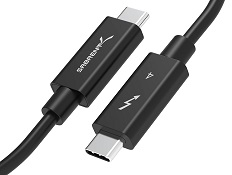What Is Thunderbolt 4?
When it comes to USB connectivity, three options pop up, USB Type-A, USB Type-C and Thunderbolt. The Thunderbolt was developed by Intel, in 2020, to further ease the hassle of connecting peripheral devices. Thunderbolt is available in four different versions, 1, 2, 3 and 4. A nifty feature of the Thunderbolt cables is that they are very easy to spot and differentiate. Every Thunderbolt cable has a Thunderbolt symbol which is accompanied by a number, which specifies the version of the Thunderbolt cable.
The features that separate Thunderbolt 4 from the rest is its bandwidth, flexibility and backwards/inter compatibility. Thunderbolt 4 boasts a bandwidth of 40Gbps (bidirectional), which makes transferring and receiving data extremely quick. In addition the port itself is capable of transferring video signals, data and capable of charging the device simultaneously. Fortunately Thunderbolt 4 is backwards compatible as well as can be connected to USB, PCle, DisplayPort and Type-C (adapters will be required, except for USB Type-C). The following chart can help you compare the thunderbolt 4 to other possible port options (Chart taken from tomshardware.com).

| The good news for people who suffer from excessive cable clutter is that due to the versatility of Thunderbolt 4, a Thunderbolt 4 dock (as shown), can be used to connect up to 11 ports and converge all the signals into one Thunderbolt 4 cable which not only reduces the amount of cable clutter but also makes mobility easier as if you have to move your monitor or laptop, you just have to plug out one cable. |  |
Gaming Advantages
The high bandwidth also unlocks the potential to plug an external GPU to your system and enjoy your gameplay at higher settings, without experiencing any sort of lag or overheating issues. In addition external devices can be used for either streaming or webcamming. The use of external or dedicated devices frees up system resources, which allows you to play games at higher graphics settings without compromising on video quality. Thunderbolt 4 is capable of recording or streaming at 4K@60Hz or 2K@120Hz or 1080p@240Hz.
Nowadays Thunderbolt 4 is available in Intel desktops as well as laptops along with in the latest versions of iPad’s and Mac’s.
Thunderbolt VS USB Type-C
While both USB Type–C and Thunderbolt are universal ports and Thunderbolt and Type-C are inter compatible, but there are some key differences between the two, which are (but not limited to)
· Increased bandwidth (From 20Gbps to 40Gbps)
· Ability to DaisyChain 4K monitors
· Thunderbolt docks offer more connectivity options as compared to Type-C ones
However, Thunderbolt cables are more expensive than Type-C’s and most budget devices don’t offer a Thunderbolt port. So the decision of choosing between Type-C and Thunderbolt is entirely subjective and depends heavily on the intended use and budget.

